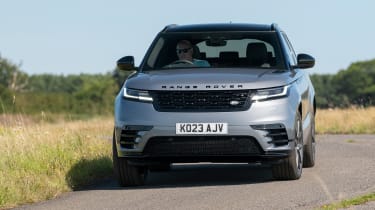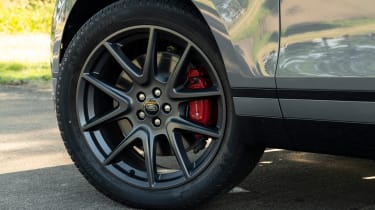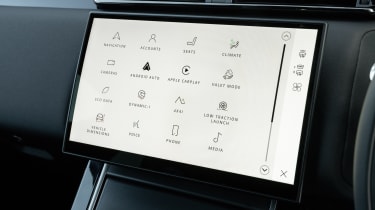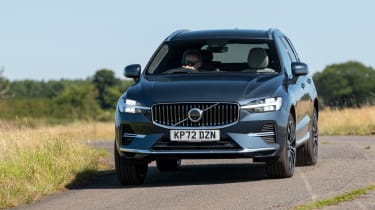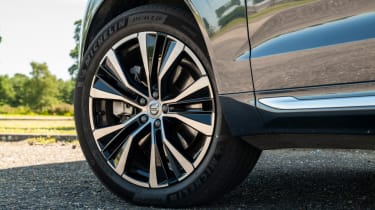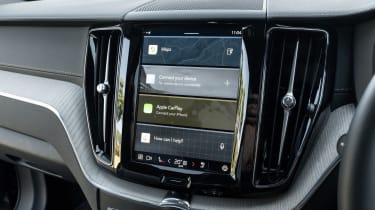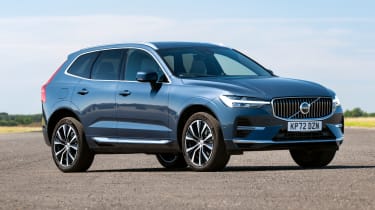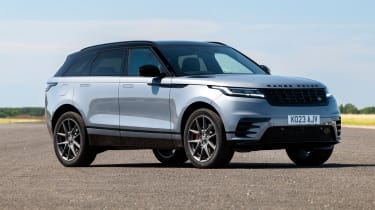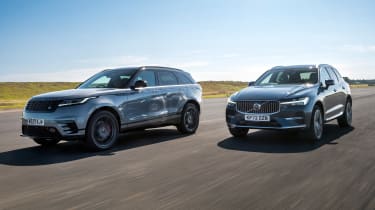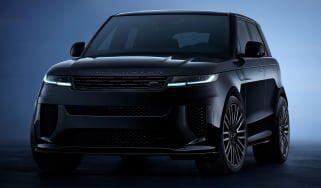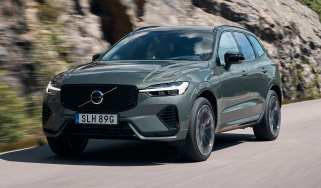Range Rover Velar vs Volvo XC60: 2023 twin test review
Can the updated Range Rover Velar beat the Volvo XC60 in PHEV guise?
If you’re after a premium SUV, then the German marques largely have you covered. Whether it’s BMW, Mercedes, Audi or Porsche, there’s a high-end machine that delivers performance, luxury and refinement in spades.
But two of the most stylish alternatives actually hail from elsewhere. The Range Rover Velar wowed with its concept-car looks when it arrived in 2017, and six years on, it still turns heads. For 2023 it’s been treated to some updates, so we’re keen to see if it has raised its game.
Against it here is the Volvo XC60. The stylish Swede seems to get better with age; the last time we subjected a plug-in hybrid variant to a group test, it saw off the Audi Q5. Plus the PHEV powertrain has been updated since then, so it should provide a stern test for the Velar.
| Range Rover Velar P400e Dynamic SE | Volvo XC60 Recharge T8 PHEV AWD Ultimate | |
| Price: | £68,860 | £67,780 |
| Powertrain: | 2.0-litre 4cyl petrol/1x e-motor, 398bhp | 2.0-litre 4cyl petrol/1x e-motor, 448bhp |
| 0-62mph: | 5.1 seconds | 4.9 seconds |
| Test efficiency: | 30.6mpg/6.7mpl | 40.2mpg/8.8mpl |
| CO2: | 40g/km | 24g/km |
| Annual VED: | £560 | £560 |
Range Rover Velar
Prices for the revised Velar kick off from £54,105, but our test car comes in the higher-specced Dynamic SE trim, and gets the most complex (and priciest) powertrain in the form of the P400e plug-in hybrid. It costs £68,860, but our car’s total is £77,095 with options.
Tech highlights
The updates to the Velar line-up are mainly cosmetic, with the most significant upgrades coming to the in-car tech that we’ll cover in the infotainment section. From the outside, the easiest way to spot the latest car from its predecessor is at the front, where there is a new grille pattern.
Used - available now

2023 Mazda
CX-5
40,211 milesAutomaticPetrol2.0L
Cash £22,599
2023 Skoda
Kamiq
43,238 milesManualPetrol1.0L
Cash £14,425
2025 Jaguar
F-Pace
47,681 milesAutomaticDiesel2.0L
Cash £41,353
2021 Ford
Fiesta
5,804 milesAutomaticPetrol1.0L
Cash £16,899Beyond this and a mildly reprofiled lower edge to the rear bumper, the Velar retains the same show-stopping looks that have proven to be a hit with buyers so far.
Mechanically it remains largely the same as before. The P400e model we have here will be the pick of the range for company car users, because its combination of a 2.0-litre petrol engine and a 141bhp electric motor results in CO2 emissions, based on the official WLTP measure, of 40g/km. A 15.4kWh (usable) battery gives an official range of 38 miles between charges.
With the two energy sources combined, the four-wheel-drive Velar isn’t short of potency; 398bhp and 640Nm enable it to sprint from 0-62mph in 5.1 seconds. That’s an impressive number for a car that weighs in at 2.3 tonnes.
Safety: When it was assessed by Euro NCAP, the Velar scored a maximum five stars. But that was back in 2017, which means the validity of the rating expires this year. All models get lane-keep assist and autonomous emergency braking, while Dynamic SE models and above add the likes of blind-spot monitoring and rear-traffic alert.
On the road
The Velar is a very accomplished SUV in terms of its road manners and comfort, but the plug-in hybrid powertrain isn’t the strongest option, either in the range or when compared with rivals.
Around town: The ability to drive in electric mode contributes to a car that is very quiet and free of vibration at low speeds. The ride comfort is controlled yet forgiving, but the electric motor shuffles through gearbox ratios, which adds a slightly clunky response as you accelerate gently.
A & B-roads: Gentle acceleration is about all you can expect from the Velar in E-mode, because it feels sluggish when the petrol engine is idle. There’s an inconsistency relative to the response from the electric motor. Squeeze the pedal hard and there’s little forward movement until the petrol engine chimes in and delivers a rapid burst of acceleration. It makes the P400e tricky to drive smoothly as the car works between the two power sources.
When the combustion and electric elements work together, the Velar feels very quick, and if you leave it in Sport mode to keep the four-cylinder unit running, it’s more coherent, although this will be to the detriment of efficiency.
Much more positive is the handling, which is excellent. It’s hard to believe that the Velar weighs as much as it does, because the chassis is very sweetly balanced, and despite the all-weather tyres of our test car, grip was strong, too.
Motorway: The smooth ride continues at higher speeds, but there’s a good level of control that still enables the Velar to feel stable and reassuring on a long-distance cruise. Plant your foot and, if the car is in EV mode, there’s a bit of a delay before you get forward movement.
Ownership
While the exterior changes are subtle, the Velar’s interior redesign is more extensive. The wide-ranging updates are driven by the introduction of the Pivi Pro infotainment system, which has an enlarged screen that takes up more space on the dashboard.
An upshot of this is that the previous slick climate functions, which mixed multifunction rotary dials with other buttons, have now been ditched in favour of on-screen controls.
The cabin takes the brand’s ‘reductive’ design philosophy to extremes, with the gear selector and hazard switch the only physical controls on the entire centre section of the dashboard.
We’d rather see a few more buttons, not only for usability but also because the bare pieces of plastic trim don’t really give the impression of a luxurious environment. That’s a shame, because apart from those slightly underwhelming materials, the cabin feels well finished and sturdy.
The seats are supportive, though, and the high driving position gives a commanding view of the road ahead. In our latest Driver Power customer-satisfaction rankings, Land Rover took a respectable 14th place out of 31 brands. However, 42 per cent of owners experienced a fault in the first year of ownership, with half of those suffering from electrical niggles and almost a fifth noting engine problems.
Storage: The interior reshuffle has opened up a little extra storage space in the dashboard, but many of the areas are largely similar to those in the pre-facelift Velar. The door bins are fairly deep, but not as wide as the XC60’s, the glovebox is a generous size, and there’s a central storage bin that, while reasonably deep, isn’t too wide.
As a result, it’s a bit of a squeeze to fit a large smartphone inside – especially if you choose to plug it into one of the USB sockets. There’s also a 12-volt socket in the same cubby.
Practicality
The PHEV powertrain doesn’t compromise what is an impressively roomy SUV.
Rear Space: Kneeroom is very impressive in the back of the Velar, with two six-foot occupants able to get comfortable easily. However, while the cabin is wide, giving great elbow room, the rear bench is set up for two rather than three. The centre seat is quite slim, the backrest is hard, and the central tunnel is quite high. The outer seats are nicely sculpted, though, so this is a very comfortable car for two rear passengers.
Boot: At 503 litres, the load bay has plenty of room. The area is almost perfectly square, and the large boot opening makes it easy to stack items inside. Four hooks enable things to be tied down securely, while a sturdy load-lip protector means there’s little need to worry about causing damage when lifting heavy luggage in.
What to buy?
Which engine and trim we’d choose
- Engines: There are two petrol and two diesel engines, with four- and six-cylinder options for each. Power ranges from 201bhp to 395bhp, with all but the P250 petrol featuring mild-hybrid tech. The P400e is the only PHEV.
- Trim: The range starts with S trim, then Dynamic SE costs £4,440 extra. Next is Dynamic HSE, while Autobiography is only available with D300 and P400 power.
- Options: Over £4,000 of our test car’s options are cosmetic, including Zadar Grey paint (£1,480), a black roof (£700) and the Black Exterior Pack (£600).
- Our choice: Dynamic SE has plenty of kit, and the D300 diesel is the best fit for the Velar.
Volvo XC60
Volvo recently renamed the trim levels on the XC60. The previous range-topping Inscription aligns with the Ultimate model we have here. At £67,780, it costs £1,080 less than its rival before options are added.
Tech highlights
The XC60 and Velar were launched at a similar time, and both have since been treated to mid-life upgrades. While Range Rover focused mostly on cosmetic aspects, Volvo has made an effort to improve the XC60’s powertrain, too.
Since the last time we assessed the XC60 PHEV, the electrical system has gained a boost. The battery has increased in size from 11.6kWh to a usable maximum of 14.9kWh, which is enough to boost the official all-electric range from 33 miles to 47 miles.
At 143bhp, the electric motor has only 2bhp more than the Velar’s, but its 309Nm peak torque is also 34Nm higher – a figure made even more significant because the XC60’s kerbweight is around 100kg lower than the Range Rover’s. As with its rival, combustion power comes courtesy of a 2.0-litre turbo petrol engine. A combined system output of 448bhp and a hefty 709Nm pulls the XC60 50bhp and 69Nm clear of the Brit.
The Ultimate model we have here comes with air suspension as standard – conventional springs and dampers are fitted to cars in Plus trim. Our test Velar didn’t have air springs – they come with more expensive HSE and Autobiography models.
Safety: The XC60 was tested by Euro NCAP in the same year as the Velar, and also achieved a five-star rating. You need to look at the individual ratings to appreciate just how well the Volvo did, though; its Adult Occupant score of 98 per cent and a Safety Assist mark of 95 per cent were the highest of any car assessed in 2017.
On the road
The Volvo’s hybrid system is more polished than the Range Rover’s, and while its chassis lags slightly behind, there’s very little between them.
Around town: At low speeds, the XC60’s electric motor feels more lively than the Velar’s, so driving in zero-emission mode doesn’t feel like such a chore. When the engine does switch on, it’s almost seamless; only a slight hum gives the game away.
Apply a little more throttle, however, and there’s just a touch more vibration than in the Velar. The same goes for the ride, which at low speed is slightly more fidgety, but we’re being picky. The steering is very light – which is great around town – but it offers less feedback than the Velar’s.
A & B-roads: Earlier versions of the XC60, whether on passive or air springs, seemed a little wayward in corners, but this newer version feels impressively tied down. It’s not a car that you choose to hustle along a twisty road – and the Velar feels more adjustable and entertaining – but it’s composed and stable.
Performance is excellent once the engine bursts into life, but while the XC60 is 0.2 seconds faster than the Velar from 0-62mph, there’s no real difference between them in the real world.
If there’s one area for improvement for the Volvo, it’s in the brakes. They can feel a little grabby when coming to a complete stop, and before that, the transition between mechanical braking and motor regen can be a little abrupt.
Motorway: The Velar is ever so slightly more hushed at high speeds, but the Volvo’s air suspension delivers a superbly smooth ride and rock-solid stability. While both are excellent cruisers, the XC60 holds a slight edge.
Ownership
Volvo’s cabin designs have changed little since the second-generation XC90 was released in 2015, and the later XC60 followed a very similar design theme. It doesn’t look as fresh as it once did, but beside its opposition here, this cabin feels as if it’s closer to nailing the ethos of minimalism.
It’s still not perfect, because the climate controls are confined to fiddly taps of the touchscreen, but otherwise the dashboard design looks clean without being quite as spartan as the Velar’s.
Our car featured optional wool-blend seat upholstery. It’s a no-cost choice that offers an alternate take on luxury to the predictable leather hides. It feels soft and looks smart – and when it’s combined with open-pore wood trim on the dashboard and the huge panoramic glass roof, the Volvo feels wonderfully light and airy inside. The seats themselves are superbly comfortable, too, and the high driving position provides a wide range of adjustment.
There was little to separate Volvo and Land Rover in the latest Driver Power manufacturer rankings, with the Swedish firm ranking just one place higher than its rival in 13th. Over a quarter of owners experienced faults with their car – a much lower percentage than Land Rover drivers, but still high when compared with many other manufacturers in the survey. Volvo owners loved their cars’ interior space and quality, though.
Storage: The Volvo’s cubby spaces are generally larger and better thought-out than those in the Range Rover. A long sliding cover in the centre console hides two cup-holders, while ahead of it is a small slot which is ideal for holding the key.
The space under the central armrest is a little more roomy than the equivalent spot in the Velar, while the glove compartment and front door bins are huge. The only minor criticism is that the bins in the back doors are a little pokey.
Practicality
The XC60 is a close match for the Velar in terms of family-friendly interior space.
Rear Space: There’s a bit more headroom in the Volvo than in the Range Rover, but this is offset by marginally less kneeroom.
The XC60’s centre seat is wider and more comfortable than the Velar’s, but there’s a high and wide transmission tunnel in the way. Fortunately, there’s loads of foot room beneath the front seats.
Child-seat installation is straightforward, thanks to Isofix mounts that are easily accessible behind folding covers.
Boot: Another benefit of air suspension is improved boot access. Press a small button inside the tailgate and the rear of the car drops by 40mm, giving a lower load lip. A capacity of 468 litres is a little smaller than in its rival, but with the seats folded, they create a flat load area of 1,395 litres, which is 60 litres more than in the Velar.
What to buy?
Which engine and trim we’d choose
- Engines: A T6 plug-in hybrid sits below the T8 in the range. It gets the same electrical system – so has the same Benefit in Kind rating – but there’s less power from the petrol engine. A combined output of 345bhp is still healthy, though.
- Trim: The T6 comes in Plus trim, and the T8 is in Ultimate spec. The latter adds air suspension, active LED lights and a head-up display. It costs £8,330 extra.
- Options: The Plus is available with full leather or part-leather trim, and the Ultimate offers leather, Nappa hide or wool seats for no extra cost.
- Our choice: If you don’t need the Ultimate’s gadgets, then the T6 Plus is a fine pick.
Results
Which car comes out on top?
Winner: Volvo XC60
The Volvo XC60 was a group test winner the last time we assessed one in PHEV form, and improvements to the powertrain have only made it stronger since then.
The electric range is one of the best in its class, and the hybrid system is smooth – a great match for a car that’s still very comfortable, relaxing and spacious. Performance is excellent, and safety remains a strong suit. It’s a solid performance from Volvo.
| Pros | Cons |
| Slick hybrid system | Fidgety low-speed ride |
| Strong EV range | Fiddly infotainment controls |
| Spacious cabin | Average boot capacity |
| Long-distance comfort | Grabby brakes |
Runner up: Range Rover Velar
Updates to the Velar are only subtle for 2023, and these changes are something of a double-edged sword. An improved infotainment system comes at the expense of the overall ergonomics, while some might find the new interior design a little too bare.
The Velar is fantastic to drive, but this PHEV powertrain is not the most convincing option,and in this form, it’s more expensive on monthly payments than the Volvo, too.
| Pros | Cons |
| Superb refinement | Clunky hybrid system |
| Engaging handling | Awkward climate controls |
| Large boot | Thirsty compared with Volvo |
| Slick infotainment system | High finance payments |
Rivals and other options
The Volvo XC60 wins our twin test, but what else is out there?
- Same class: Lexus NX 450h+
- Same money: Mercedes GLC 300 e
- Used: Mitsubishi Outlander
- Used: BMW X5 xDrive45e
- Coming soon: Audi Q5 TFSI e
The great debate
What the Auto Express test team would do…
Sean Carson, associate editor: “It’s hard to think of two cars that have aged more gracefully in this segment. But Volvo’s approach can be a lesson for JLR here – it hasn’t just focused on superficial updates; by improving the mechanicals of the XC60, it’s kept it fighting towards the top of the class.”
John McIlroy, deputy editor: “Volvo has been more vocal than most brands about becoming EV-only, and it feels like the constant improvements to its PHEV tech are a dress rehearsal for its battery-only successors. We’re excited to find out how the EX30, the brand’s new electric baby SUV, will fare.”
Dawn Grant, picture editor: “JLR is relying on desirability to sell cars. The XC60 has a small edge over its rival – even before the Swede’s finance figures come into play – but some buyers won’t care. The Velar looks brilliant and drives well, which its maker hopes will be enough to justify the premium for customers.”
Steve Fowler, editor-in-chief: “This is a class where these two brands can really stamp their mark. The BMW X3 isn’t at its brilliant best in PHEV form, the new Audi Q5 above is a way off, and the Mercedes GLC hasn’t quite hit the spot. Unfortunately it seems that Lexus has everyone covered with the outstanding NX.”
Dean Gibson, senior test editor: “More than ever, it’s worth doing the sums to work out whether a PHEV makes financial sense. Conventional petrol and diesel versions of the Velar are cheaper to buy, and unless you can top up the PHEV battery on a cheap tariff, it’ll be difficult to claw those costs back.”
Which would you buy? Let us know in the comments section below…
Specs and prices
| Range Rover Velar Dynamic SE P400e | Volvo XC60 Recharge PHEV T8 AWD Ultimate | |
| Petrol or diesel | Petrol | Petrol |
| MPG (WLTP) | 30.6 | 40.2 |
| Fuel price | £1.50 | £1.50 |
| P11D value | £68,805 | £68,330 |
| Fill up | £104.05 | £105.50 |
| On the road price/total as tested | £68,860/£77,095 | £67,780/£68,465 |
| Residual value (after 3yrs/36,000) | £43,127 (62.6%) | £34,737 (51.3%) |
| Depreciation | £25,733 | £33,043 |
| Annual tax liability std/higher rate | £1,651.32/£3,302.60 | £1,093.28/£2,186.60 |
| Annual fuel. cost (10k/20k miles) | £2,240 (£4,481) | £1,705 (£3,411) |
| Ins. group/quote/VED | 44/£2,194/£560 | 42/£1,521/£560 |
| Service costs (3 years) | £453 | £699 |
| Length/wheelbase | 4,797/2,874mm | 4,708/2,865mm |
| Height/width | 1,683/2,041mm | 1,651/1,939mm |
| Powertrain | 4cyl, 1x e-motor/1,998cc | 4cyl, 1x e-motor/1,969cc |
| Total system power | 398 bhp | 448 bhp |
| Total system torque | 640 Nm | 709 Nm |
| Electric motor power/torque | 141/275 bhp/Nm | 143/309 bhp/Nm |
| Battery size/usable | 19.2kWh/15.5kWh | 18.8kWh/14.9kWh |
| Transmission | 8-spd auto/4wd | 8-spd auto/f4d |
| Boot capacity (front / seats up/down) | 503/1,335 litres | 468/1,395 litres |
| Kerbweight/payload/towing weight | 2,280/460/2,000kg | 2,163/497/2,250kg |
| Turning circle | 12.0 metres | 11.4 metres |
| Basic warranty/recovery | 3yrs (unlimited)/1yr | 3 yrs (60,000)/3yrs |
| Driver Power manufacturer position | 14th | 13th |
| Euro NCAP: Adult/child/ped./assist/stars | 93/85/74/72/5 (2017) | 98/87/76/95/5 (2017) |
| 0-62mph/top speed | 5.1 seconds/130mph | 4.9 seconds/112mph |
| Test economy / range | 30.6/464 | 40.2/619 |
| WLTP combined | 163.5mpg | 256.8mpg |
| Claimed EV range | 38 miles | 47 miles |
| Charge time | 2h 30/30 mins (7kW/50kW) | 3h (6.4kW) |
| Actual/claimed CO2/tax bracket | 213/40g/km/12% | 162/24g/km/8% |
| Number of airbags/Isofix points | Six/two | Seven/two |
| Parking sensors/360 camera | F&r/£630 | F&r/yes |
| Lane-keep assist/blindspot/AEB | Yes/yes/yes | Yes/yes/yes |
| Climate control/adaptive cruise ctrl | Yes/yes | Yes/yes |
| Leather/heated seats | Yes/front | Yes/f&r |
| Metallic paint/LED lights | £760/yes | £695/yes |
| Keyless entry & go/powered tailgate | Yes/yes | Yes/yes |
| Sat-nav/digital dashboard/USBs | Yes/yes/four | Yes/yes/four |
| Online services/wireless charging | Yes/yes | Yes/yes |
| Apple CarPlay/Android Auto | Yes/Yes | Yes/Yes |


